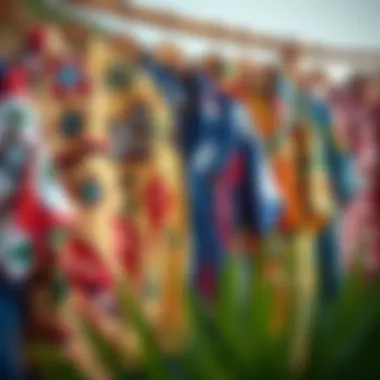The Timeless Appeal of Vintage Surf Fashion


Intro
The world of vintage surf clothing is a colorful tapestry woven from the threads of history, culture, and personal expression. This niche segment of fashion, while primarily tied to the sport of surfing, has created a significant impact on the broader landscape of style and identity. For those enchanted by surf culture, vintage surf clothes offer a tangible connection to the ocean, freedom, and a lifestyle that many aspire to encapsulate.
Fueled by nostalgia and a longing for authenticity, vintage surf clothing serves not only as a fashion statement but also as a vessel of history. Each piece unfolds tales of the evolution of surf style, often reflecting the decades and different influences that have shaped the surfing community. From the bold colors of the 70s to the minimalist aesthetics of the 90s, clothing trends mirror societal shifts entirely.
In this exploration, we will delve deeper into the allure of these timeless pieces. We will also be discussing their craftsmanship, how these garments have stood the test of time, and their relevance in today’s fashion landscape. Whether you're a seasoned surfer or just someone trying to capture that beach vibe, understanding the story behind vintage surf clothing can enrich your appreciation and inspire your personal style.
Let's ride this wave as we discover how vintage surf fashion offers more than just aesthetic appeal—it embodies a way of life, merging art, sport, and cultural identity.
Understanding Vintage Surf Clothing
Vintage surf clothing encapsulates more than just a fashion statement; it serves as a bridge between generations of surf culture, embodying the spirit and creativity of past eras. Understanding this niche of fashion allows enthusiasts to appreciate the deeper narratives woven into each piece.
Wearing vintage surf gear is like wearing a slice of history. The unique characteristics of these clothes—such as bold patterns, faded fabrics, and intricate designs—invite not only admiration but also a connection to the surfing lifestyle.
Definition and Characteristics
Vintage surf clothing refers to apparel from the late 20th century, specifically from the 1960s to the early 1980s, during which surfing burgeoned into a mainstream sport and culture.
These items often show characteristics like:
- Bright colors: Many vintage pieces feature vibrant hues and unique patterns, often inspired by Hawaiian culture and the natural beauty of coastal landscapes.
- Distinctive shapes: Think relaxed fits and loose silhouettes, prioritizing comfort for both surfing and casual wear.
- Quality: Older items often boast superior craftsmanship, employing methods that have fallen out of favor with mass production today.
Cultural Relevance
The significance of vintage surf clothing extends beyond aesthetics. It reflects an era of liberation and creativity in surf culture. During the radical upheaval of the 1960s, surf fashion proved to be a form of self-expression, particularly for the youth. Clothes from this time symbolize a carefree lifestyle and the pursuit of adventure. For many, donning vintage apparel is more than just style; it’s an act of homage to the pioneers of surfing and a way to keep the spirit of the ocean alive.
Thus, wearing vintage surf clothing makes a broader statement on identity and community, passionately celebrating a vibrant culture that is inherently tied to the environment and personal freedom.
Key Brands and Designers
Several brands and designers prominently shaped vintage surf wear, setting trends that carry influence even today. Their contributions are noteworthy:
- Hobie Surfboards: Pioneered styles that showcased both functionality and flair. Hobie clothing reflects the laid-back Californian vibe.
- O’Neill: Known for creating innovative wetsuits and surf gear, emphasizing both style and utility.
- Billabong and Rip Curl: Though still active today, their vintage lines speak volumes of past designs, merging nostalgia with innovation.
These brands not only created practical clothing for surfers but also contributed to the broader cultural movement that defined surf aesthetics. Their designs encapsulated an ethos of freedom and creativity, making them timeless pieces valued by collectors today.
"Vintage surf clothing is not just apparel; it is a story—woven from the waves, the sun, and the spirit of adventurous souls."
In summary, understanding vintage surf clothing involves recognizing its layered significance—how it encapsulates history, influences contemporary styles, and contributes to a sense of identity within the surf community.
The Historical Context of Surf Fashion


Origins of Surf Culture
Surf culture, as we know it today, originated in the early 20th century, particularly in the idyllic beaches of California and Hawaii. It was during this time that Hawaiian royalty first introduced surfing to a wider audience, showcasing the sport's grace and artistry. Early surfers were attired in simple garments, often made from wool or cotton, which could become quite cumbersome when wet. However, as the sport began to gain popularity, especially in California during the 1960s, surfers started embracing bolder colors and patterns that reflected their exuberance. These early clothes were not merely functional; they became symbols of liberation and rebellion, tightly woven into the fabric of counterculture.
Evolution Through the Decades
As surfing evolved, so did the clothing associated with it. The 1950s and 1960s marked a watershed moment, where designs began to reflect the carefree spirit of the beach lifestyle. The emergence of surf brands like O'Neill and Quiksilver punctuated this era, leading to the introduction of board shorts and lightweight shirts designed specifically for performance in water.
Throughout the 1970s and 1980s, surf fashion took another turn with the advent of punk and skate culture. This resulted in a mash-up of styles, where vibrant patterns and graffiti influences prevailed. Think about brightly colored Hawaiian shirts paired with dark denim — it was a juxtaposition that mirrored the rebellious attitude of the youth. Popular surf films like Endless Summer and Big Wednesday played a substantial role in cementing these trends, leaving a lasting impact not only on surfing but on general fashion.
Iconic Surf Movies and Their Impact
Surf movies have long acted as cultural touchstones, shaping perceptions and styles within the surf community. Films such as The Endless Summer showcased not only breathtaking surf locations but also the clothing styles that resonated with those participating in the surf lifestyle. The surfer’s idiosyncratic garb—whether it be tie-dye T-shirts or brightly printed boardshorts—was as important to the film's imagery as the waves themselves.
"Surf films serve as a reflection of the times, acting as a bridge between fashion and identity while igniting a passion for adventure and freedom."
The impact of these movies reached far beyond just the surfing community; they popularized surf culture on a global scale, introducing an entire generation to the essence of the sport through its aesthetic. Vintage surf movies remain a rich source of inspiration, as they encapsulate a spirit of exploration that continues to resonate with surfers and fashion enthusiasts alike.
Materials and Craftsmanship in Vintage Surf Wear
The soul of vintage surf clothing lies not only in its aesthetics but also in the materials and craftsmanship that bring it to life. Understanding these elements is crucial for anyone looking to appreciate or collect vintage surf wear. The nuances of fabric choices, the artistry behind production methods, and the impact of sustainability play a significant role in defining the allure of these garments.
Natural vs. Synthetic Fabrics
When it comes to surf apparel, choices of fabrics can be a game changer. Natural fabrics such as cotton and linen are often favored for their breathability and comfort. They allow the skin to breathe, which is especially important for surfers and beachgoers who might get hot under the sun. Cotton tends to soften with age, thus adding character to the piece as it becomes more comfortable over time.
On the other hand, synthetic fabrics, like polyester and nylon, are known for their durability and quick-drying properties. This makes them particularly attractive for active lifestyles. Surfers can appreciate the practicality of these materials, especially when dealing with wet suits or board shorts. However, not all synthetic fabrics are created equal; the quality can vary greatly among brands. It’s essential to consider the top-notch brands that use advanced technologies for durability while keeping comfort in mind.
"The choice of fabric can determine not just the comfort but also the longevity of vintage surf apparel."
Sustainability Considerations
In today's world, sustainability has become a hot-button topic, and it’s equally relevant in the realm of vintage surf clothing. Many fabrics used in vintage surf wear, especially those produced in earlier decades, were derived from more natural sources with fewer chemicals. This often means that older garments have lower environmental footprints compared to some modern synthetic options. However, the importance of sustainability extends beyond fabric choice.
As collectors and enthusiasts become more conscious of their environmental impacts, vintage clothing offers a unique opportunity. By opting for these styles, individuals can reduce waste while preserving a piece of surf culture history. When buying vintage surf wear, look for brands that prioritize eco-friendly practices, ensuring that the garment was made with care for both the environment and the craft.
Techniques and Production Methods
The craftsmanship of vintage surf apparel is a tapestry of various production methods that can determine both quality and style. Before automation took over, many garments were hand-made or produced in smaller runs. This often imbued each piece with a unique touch, a style that mass-produced counterparts lack. Typical techniques included serging, embroidery, and dyeing, all of which allowed for creativity and individuality.
For instance, embroidered logos and intricate patterns were popular in surf t-shirts and board shorts, highlighting the surfer’s taste and style. Companies like Ocean Pacific and Vans used colors and prints that resonated with the ocean's dynamism, making their products stand out.
The process of fade and wear also tells a story. Vintage seekers appreciate the worn-in feel that comes from years of enjoyment. This wear can reflect the adventures of its previous owner, adding layers of narrative to the garment itself.
In summary, the fabrics and craftsmanship defining vintage surf wear not only enhance comfort and functionality but also link directly to broader themes of sustainability and individuality. Understanding these elements serves to deepen appreciation for what lays beyond the surface of style in the world of surf fashion.


Collecting Vintage Surf Apparel
Collecting vintage surf apparel is more than just a hobby; it can be a doorway into the vibrant history and culture of surfing. The act of curating a collection of these specialized garments serves a dual purpose: it's a means of preserving surf heritage and an avenue for personal expression. Vintage surf wear allows collectors to connect with a time when the surf scene was profoundly unique, and embracing changes in style often reflected broader cultural shifts.
How to Identify Authentic Pieces
To determine the authenticity of vintage surf clothing, one must adopt a meticulous approach. It's essential to familiarize yourself with the telltale signs that distinguish genuine pieces from replicas. Here are several pointers to consider:
- Labels and Tags: Examine the labels closely. Original brands like Hurley, Billabong, or Quiksilver have evolved over time. Their labels can give clues about the piece's age.
- Stitching Quality: Authentic vintage pieces often boast exceptional craftsmanship. Machine stitching may be present, but hand-stitched details are usually indicative of authentic, older items.
- Fabric Types: Vintage clothing typically utilizes natural materials. Feel the texture—if it has an outdated, rough feel, it might be genuine. Modern synthetic blends are often smoother and lighter.
When in doubt, always cross-reference with trusted sources or communities online. Sites such as reddit.com/r/vintagesurf can be invaluable for shared knowledge and experience.
Valuable Styles and What to Look For
The hunt for valuable vintage surf wear can be both exciting and rewarding. Some styles tend to command more attention and might fetch a higher price among collectors. Here are a few sought-after styles:
- Boardshorts from the 70s: Bright cartoonish patterns or tie-dye are typical of this era. Look for those made by brands like Ocean Pacific and Lightning Bolt.
- Rash Guards from the 80s: Nautical themes or garish colors can signify authentic pieces. Brands like Rip Curl and Body Glove are hallmark names.
- Graphic Tees featuring Surf Brands: Vintage shirts, particularly those highlighting the surf culture's icons or events, hold significant value.
When evaluating a piece, also consider its condition. Minor wear can enhance its character, but extensive damage could diminish value.
Caring for Vintage Clothing
Caring for vintage surf clothing is crucial to maintain its integrity and longevity. Given the age of many pieces, a gentle hand is required.
- Washing Method: Always opt for cold water and mild detergent. Hand washing is preferred, but if a machine is necessary, use a delicate cycle.
- Drying Recommendations: Avoid tumble drying. Instead, let pieces air dry away from direct sunlight to prevent fading.
- Storage Tips: Store garments flat or on padded hangers to prevent distortion. Be mindful of humidity and temperature to avoid mildew.
"Taking care of vintage surf wear is like nurturing a piece of history; you’ll want it to remain as vibrant as the waves it once rode."
By embracing the tenets of careful collecting and preservation, you not only delight in your vintage surf apparel but also contribute to the larger surfing narrative, keeping alive the spirit that has always dictated surf culture.
Incorporating Vintage Styles into Modern Wardrobes
The juxtaposition of vintage surf clothing with contemporary fashion forms a fascinating narrative that not only reflects personal taste but also embodies a rich cultural heritage. As vintage styles reemerge, they offer enthusiasts avenues to mix nostalgia with modern aesthetics, creating unique ensembles that turn heads without losing the essence of surf culture.
Mixing Vintage with Contemporary Fashion
When it comes to mixing vintage surf gear with today’s styles, it’s all about balance. A sprinkle of the old can truly freshen up the new. Have you ever pondered a classic Hawaiian shirt, cherished from a past surf trip, paired with a sleek pair of modern denim? This harmony between eras doesn’t regularly require a complicated approach; mastering this art mostly involves understanding fit, colors, and textures.
- Choose One Statement Piece: Selecting a standout item, like a retro surf jacket or a pair of boardshorts, can be your anchor point. From there, build an outfit that interacts well with the chosen piece.
- Layer Smartly: Lightweight vintage shirts worn over current t-shirts offer that laid-back surfer vibe without feeling disjointed.
- Mind the Footwear: A pair of classic sneakers can breathe new life into a vintage ensemble while keeping it grounded and relevant.
These are just a few ideas to stir that creative pot. Vintage pieces should enhance, not overshadow, modern silhouettes. By incorporating items that have a story, you also bring an element of individuality into your wardrobe, which is a mark of true style.
Creating a Personal Style Statement
In the world of fashion, expressing oneself is king. Vintage surf clothing allows for a distinct style statement that speaks volumes about one's personality and perceptions. Integrating these nostalgic pieces allows a unique dialogue between past and present.


- Storytelling Through Clothes: Each vintage piece has its own story—sharing where it’s been or what waves it’s ridden. Wearing something with a history can act as a conversation starter, revealing layers of connection to surf culture.
- Explore Various Subcultures: Surf fashion, with its many facets, opens a realm of possibilities. It’s pretty much like a layered cake; from the bright colors of the 70s to the more subdued tones of the 90s—each era provides fresh inspiration to express different facets of identity.
- Accessorize Thoughtfully: Adding modern touches like unique sunglasses or a contemporary backpack can tie the whole look together seamlessly. This allows the wearer to maintain practicality while paying homage to their vintage roots.
Vintage surf apparel isn’t just clothing; it’s a celebration of identity, an expression of connection to the timeless waves and the culture that surrounds them.
Using vintage surf clothing thoughtfully doesn’t merely produce an outfit; it crafts a cohesive story. For surfers, instructors, and anyone engaged with marine environments, this blend not only honors the surf tradition but elevates their creative expression in ways that are both meaningful and visually stunning.
The Role of Vintage Surf Clothing in Modern Surf Culture
Vintage surf clothing holds a unique space in the realm of modern surf culture, acting as a bridge between the past and the present. The pieces from yesteryear are not just clothes; they're artifacts that represent a lifestyle steeped in freedom, creativity, and connection to the ocean. Wearing vintage surf apparel becomes a way for individuals to celebrate their identity and emphasize the culture that shaped modern surfing.
Influence on Current Trends
The charm of vintage surf clothes is undeniable, influencing today’s fashion trends in various ways. Whether it's the bold colors or graphic prints reminiscent of the 70s and 80s, these styles inspire a resurgence in nostalgia-driven designs. Many contemporary brands are tapping into retro aesthetics to create collections that resonate with both seasoned surfers and younger enthusiasts.
- Rescue of Vintage Styles: The surf industry sees many brands re-launching classic styles. For example, companies like O’Neill and Billabong have revamped their older styles, blending timeless designs with modern materials.
- Streetwear Influence: Urban fashion often borrows from the surf scene. The rise of streetwear has merged casual surf styles with everyday attire, allowing newcomers to express their love for the ocean while remaining stylish in urban settings.
- Sustainable Practices: The fashion world is pivoting toward eco-friendliness. Many surf brands are now producing clothing with recycled materials or organic fabrics, which can be traced back to the sustainable spirit of vintage surf clothing that prioritizes quality over quantity.
In this sense, vintage surf apparel does not just serve as inspiration but highlights a shift toward more thoughtful fashion choices that respect both heritage and the planet.
Community and Identity
Wearing vintage surf clothing tells a story about community and personal identity among surfers. It reflects a shared understanding of the surfing lifestyle and the values that come with it. The ties that bind these individuals run deep, often stemming from the love of the ocean and the culture surrounding it. Vintage surf clothes help create an atmosphere of camaraderie, as they tend to pop up in shared spaces—from surf shops to casual beach gatherings.
- Shared History: Pieces like board shorts from the 80s or graphic tees with logos from now-defunct brands resonate with memories of surf trips and camaraderie, reigniting passions and moments from years gone by.
- Cultural Identity: Vintage clothing options push against the mainstream, allowing people to carve out their unique styles based on different periods in surf history. By wearing these clothes, surfers can connect with a subculture that values authenticity and the stories behind each piece.
- Collective Memory: Vintage fashion represents a collective journey of the surf community. When one dons a classic surf hoodie or an older pair of shorts, it symbolizes a connection not just to personal experiences but to a larger narrative, thus enriching the individual’s sense of belonging.
"Surfing is not just a sport, it is a lifestyle, a community, and vintage apparel serves to remind us all of that connection."
In summary, vintage surf clothing stands as more than just fabrics stitched together; it embodies a culture and history that continues to weave itself into the fabric of modern surfing. As current trends echo through shades and styles of the past, the community thrives by wearing their stories proudly, ensuring that both heritage and identity persist in an ever-evolving surf landscape.
For more information on the surf culture and its evolution, visit Wikipedia, or discover communities on platforms like Reddit.
The Future of Vintage Surf Fashion
The future of vintage surf fashion stands at a crossroads where nostalgia meets innovation. As surf culture continues to evolve, it makes sense to discuss how vintage apparel—clothes that once symbolized a carefree, beach-loving lifestyle—retains its charm and relevance. This section examines key elements that are shaping the future of this niche in the fashion industry, exploring both emerging trends and significant considerations regarding sustainability. Understanding these factors is crucial not only for enthusiasts and collectors but also for surf brands aiming to adapt and thrive in a dynamic market.
Emerging Innovations and Trends
The landscape of vintage surf clothing is witnessing fresh innovations that mix the old with the new. Here are a couple of significant trends making waves:
- Technology Integration: Innovative fabrics and production techniques are now incorporated into vintage styles. Brands are embracing advancements like moisture-wicking materials and UV protection while maintaining the iconic designs of the past. Retro board shorts, once simple in their construction, now come equipped with features typical of modern athletic apparel, creating a blend of practicality and style.
- Reimagined Classic Designs: Several surf brands are adopting a practice of retro-releasing classic designs. This means that while the patterns and color schemes may harken back to the 70s or 80s, they are manufactured using current, high-performance materials. This helps to keep the essence of vintage alive while addressing modern demands.
The emergence of these trends opens doors for the next generation of surfers to engage with the sport's history. For instance, surf shops are beginning to highlight old-school looks paired with modern fits, allowing younger surfers to embody that timeless vibe without compromising comfort.
Sustainability in the Surf Industry
Sustainability remains a talking point that grows in importance as the reality of climate change looms over industries, including surf fashion. The surf market, particularly vintage clothing, is beginning to embrace practices that reflect environmental consciousness. Here’s a closer look at how this unfolds:
- Eco-Friendly Materials: Many surf brands are turning to recycled materials, such as ocean plastics and organic cotton blends. These materials are no longer merely an afterthought; they're becoming a standard practice in the manufacturing of surf clothes. Using eco-friendly processes not only appeals to consumers who are conscious about their environmental footprint but also ensures that production aligns with the values of many modern surfers.
- Circular Fashion Model: Another innovative approach being discussed is the move towards a circular fashion model. This entails designing products with the end in mind—to be recycled or repurposed instead of ending up in landfills. Brands are starting initiatives that encourage customers to return their used clothing for recycling or upcycling. Vintage shops often emphasize buying and selling second-hand, thus inherently promoting this sustainable approach.
"The future is all about blending the legacy of surfing with the values we hold dear today, especially regarding our planet." - Surf Industry Leader
As we look ahead, it's evident that the future of vintage surf fashion will not simply be a continuation of what has come before. Instead, it will weave in new threads of technology and sustainability while continuing to honor the cultural roots that define surf culture. Surfers, instructors, beach lifeguards, outdoor writers, and marine biologists alike will find value in embracing not just the aesthetic of vintage clothing but the stories and ecological considerations that shape its future.















